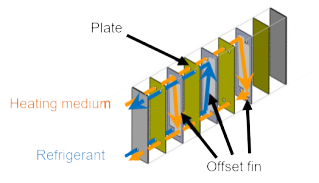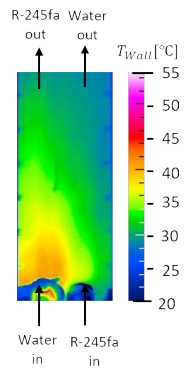Study on Heat Flow Characteristics of Refrigerant Flow in Plate Fin Heat Exchanger
Purpose
 |
A heat pump system that can recover waste heat and supply larger amounts of heat at higher temperature is expected to solve a global warming problem.
Plate fin heat exchanger with low heat loss and high heat transfer area density is expected for the heat pomp system. The target of this study is a plate fin evaporator.
The plate fin heat exchanger composed of a stack of wide flat flow channels with offset fins. Since the refrigerant is distributed into multiple flow paths, refrigerant flow distribution might affect on heat transfer characteristics.
On the other hand, for the compactness, the inlet and outlet ports of each fluid are located at the four corners as shown in the right figure, so the flow distribution in each channel is also important.
The refrigerant is heated by hot water, and the temperature of hot water decreases with the heat exchange. So, the local temperature difference between the fluids is non-uniform.
It is considered that the heat flux might be non-uniform. For the counter flow, the heat flux would be higher at the exit of the refrigerant flow with higher vapor quality and for the parallel flow, the heat flux would be higher at the inlet of the refrigerant flow with lower vapor quality or subcooling.
The purpose of this study is to clarify the effect of the flow direction of the hot water on the heat exchange performance for vertically upward boiling refrigerant flow in a single-layer plate fin heat exchanger with offset fins.
Research content
 |
The object is vertically upward boiling flows in a single-layer plate fin heat exchanger.
Refrigerant is heated by hot water. In order to evaluate the distribution of heat transfer amount, the temperature distribution on the outer wall surface of the hot water channel was visualized and measured with an IR camera.
It has been confirmed in the preliminary experiments that heat loss through the channel wall of hot water can be negligibly small.
Since aluminum offset fins are installed in the hot water channel, the wall temperature can be approximate to show the hot water temperature distribution. On the other hand, the refrigerant flow behaviors are observed with a high-speed camera by replacing the outer wall to a transparent poly-carbonate resign plate.
The right figure shows the results for parallel flow using R-245fa as the refrigerant. Boiling heat transfer characteristics are evaluated form the temperature distribution of hot water and refrigerant flow behaviors.
Publications
式地 千明, 上野 貴之, 箕浦 健二, 浅野 等
単流路プレートフィン熱交換器内垂直上昇沸騰熱伝達に及ぼす加熱媒体流動方向の影響, 日本冷凍空調学会論文集 34(4) (2017), pp.453-461.
https://doi.org/10.11322/tjsrae.17-53HE
式地 千明, 富永 悠揮, 浅野 等
オフセットフィンを内蔵したプレートフィン熱交換器内気液二相流の流動特性に関する研究, 日本冷凍空調学会論文集 34(1) (2017), pp.13-24.
https://doi.org/10.11322/tjsrae.16-30
K. Shikichi , T. Ueno , H. Asano
Effect of Flow Direction of Heating Medium on Heat Transfer Performance
of Single-Path Plate-Fin Evaporator, Proc. of the ASME 2017 Power Conference
Joint With ICOPE-17, #POWER-ICOPE2017-3278 (2017). https://doi.org/10.1115/POWER-ICOPE2017-3278